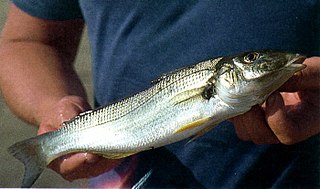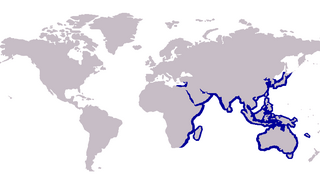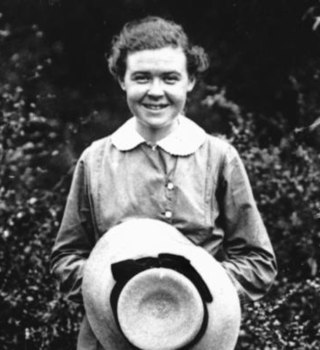Related Research Articles
Australian Biological Resources Study (ABRS) is a project undertaken by the Parks Australia Division of Australia's Department of Climate Change, Energy, the Environment and Water.

The King George whiting, also known as the spotted whiting or spotted sillago, is a coastal marine fish of the smelt-whitings family Sillaginidae. The King George whiting is endemic to Australia, inhabiting the south coast of the country from Jurien Bay, Western Australia to Botany Bay, New South Wales in the east. The King George whiting is the only member of the genus Sillaginodes and the largest member of the smelt-whiting family Sillaginidae, growing to a length of 80 cm and 4.8 kg in weight. The species is readily distinguishable from other Australian whitings by its unique pattern of spots, as well as its highly elongate shape. King George whiting are often found in bays and protected waterways over sand and seagrass beds, also venturing out onto deep continental shelf reefs during adulthood. The species is a benthic carnivore, consuming a variety of crustaceans, polychaete worms, molluscs and fish. The King George whiting forms the basis of one of southern Australia's most important commercial fisheries, reportedly worth over five million Australian dollars per year. The species is also heavily targeted by recreational anglers, who value the whiting for its sporting and eating qualities.

The sand whiting, also known as the summer whiting, yellowfin whiting or blue-nose whiting, is a common species of coastal marine fish of the family Sillaginidae, the smelt-whitings. It is a slender, slightly compressed fish that is very similar to other species of Sillago, with detailed spine, ray and lateral line scale counts needed to distinguish the species between its nearest relative Sillago analis. The sand whiting is distributed along the east coast of Australia from Cape York south to Tasmania, as well as Lord Howe Island and New Caledonia in the Pacific Ocean.

The stout whiting, also known as the yellow-cheek whiting or school whiting, is a species of benthic marine fish in the smelt-whiting family Sillaginidae. Like other sillaginids, it is an elongate, slightly compressed fish, growing to a maximum known length of 30 cm. The stout whiting is endemic to Australia, with the species divided into western and eastern populations, with the western population ranging from Shark Bay to Fremantle and the eastern population from Bustard Head, Queensland to northern New South Wales. The species inhabits deep, sandy continental shelf regions to a depth of at least 70 m.

The bluespotted trevally, also known as the wide-mouthed trevally, is a species of moderately large marine fish in the jack family Carangidae. The bluespotted trevally is distributed through the tropical east Indian and west Pacific Oceans, ranging from Taiwan in the north to Australia in the south. It is an inshore species, found in sandy, muddy and seagrass environments, often in large bays. The bluespotted trevally is distinguished by dark blue spots on its upper body, as well as a number of more detailed anatomical features. It is a benthopelagic predator, taking a variety of crustaceans including crabs and prawns as a juvenile, before shifting to a more fish-dominated diet as an adult. It is one of the most common predators in the Gulf of Carpentaria of northern Australia, and is considered the most important predator of commercially important prawn species. Sexual maturity is reached at 110 mm in length and one year of age, with spawning occurring year round with a peak in spring. Growth is estimated to be 82.2 mm per year for both sexes, reaching a maximum known length of 66 cm. Bluespotted trevally are commonly taken as bycatch in prawn fisheries, however are of little commercial value and often discarded. They are occasionally taken by anglers on lures and baits, but are considered mediocre table fare.

Smelt-whiting is the common name for various species of the family Sillaginidae. The Sillaginidae are distributed throughout the Indo-Pacific region, ranging from the west coast of Africa to Japan and Taiwan in the east, as well occupying as a number of small islands including New Caledonia in the Pacific Ocean. Well known members of this family include King George whiting, Japanese whiting, northern whiting, sand whiting and school whiting.

The eastern shovelnose ray is a species of guitarfish in the family Rhinobatidae of order Rhinopristiformes. The species is endemic to the east coast of Australia and inhabits subtropical and temperate waters from southern Queensland to southern New South Wales.

Klaus Rohde is a German biologist at the University of New England (UNE), Australia, known particularly for his work on marine parasitology, evolutionary ecology/zoogeography, and phylogeny/ultrastructure of lower invertebrates.

Lernaeocera branchialis, sometimes called cod worm, is a parasite of marine fish, found mainly in the North Atlantic. It is a marine copepod which starts life as a small pelagic crustacean larva. It is among the largest of copepods, ranging in size from 2 to 3 millimetres when it matures as a copepodid larva to more than 40 mm as a sessile adult.

Microcotyle is a genus which belongs to the phylum Platyhelminthes and class Monogenea. Species of Microcotyle are ectoparasites that affect their host by attaching themselves as larvae on the gills of the fish and grow into adult stage. This larval stage is called oncomiracidium, and is characterized as free swimming and ciliated.

Mabel Josephine (Jo) Mackerras was an Australian zoologist, entomologist and parasitologist. Her research and life's work contributed to entomology, veterinary medicine and medical science. Throughout her life she held a wide range of positions and duties that included Army medical officer, entomologist, medical scientist, and parasitologist. Mackerras was a major during WWII and served in the Army Malaria Research Unit. In an application for King's Birthday Honours her work earned the citation,: "few women can have made a greater contribution to the Allied war effort".
Kenneth Radway Allen was a New Zealand fisheries biologist.

Thomas Harvey Johnston was an Australian biologist and parasitologist. He championed the efforts to eradicate the invasive prickly pear.

The Australian Society for Fish Biology (ASFB) is a professional organisation of fish and fisheries researchers. Founded in 1971, the society describes itself as a "professional, independent, non-profit, non-commercial and non-aligned organisation." The Australian Society for Fish Biology holds annual conferences for its members, sometimes in partnership with related organisations such as the Oceania Chondrichthyan Society and the Australian Society for Limnology. Former presidents of the society include Hamar Midgley (1977–79), Gerry Allen (1979–81), Julian Pepperell (1991–93) and Bronwyn Gillanders (2012–13).
The Moreton Bay Research Station is a marine biology research centre located on North Stradbroke Island, off the coast of Brisbane, Queensland, Australia, in Moreton Bay and the Pacific Ocean.
The K. Radway Allen Award is the highest honour awarded by the Australian Society for Fish Biology. It recognises individuals who have made an "outstanding contribution in fish or fisheries science." The award, inaugurated in 1995, is named for New Zealand fisheries biologist Kenneth Radway Allen.
John Richard Paxton is a United States-born Australian ichthyologist, who spent most of his career at the Australian Museum. He has a particular research interest in lanternfishes and other deep-sea fishes. Paxton is a founding member of the Australian Society for Fish Biology and received the society's K. Radway Allen Award in 1997.
Andre Eric Punt is a South African fisheries scientist and mathematician, best known for his work on fisheries stock assessment. He received the K. Radway Allen Award in 1999 for his contributions to fisheries science.
Norman George Hall is an Australian fisheries scientist, known for his work on fisheries modelling and fisheries stock assessment. He received the K. Radway Allen Award in 2005 for his contributions to fisheries science.
Elizabeth A. Fulton, also known as Beth Fulton, is an Australian ecosystem modeller, who was elected a Fellow of the Australian Academy of Science in 2022. She is a Research Group Leader at CSIRO Oceans & Atmosphere in Hobart, Tasmania.
References
Notes
Citations
- 1 2 3 4 5 6 7 8 9 10 11 12 13 14 15 16 17 18 19 20 21 22 23 24 25 26 27 28 B.M. Angus, L.R.G. Cannon, & R.D. Adlard (2007) "Parasitology and the Queensland Museum, with biographical notes on collectors". Memoirs of the Queensland Museum, 53(1): 1–156. Brisbane. ISSN 0079-8835.
- 1 2 "K. Radway Allen Award", Australian Society for Fish Biology, official website. Accessed 25 July 2019.
- 1 2 3 4 5 6 7 8 9 "Peter Young" Australian Society for Fish Biology official website. Accessed 25 July 2019.
- ↑ Ward, Colin (24 July 2013). "Marine and Atmospheric Research Divisions". CSIROpedia. Archived from the original on 12 March 2023. Retrieved 12 March 2023.